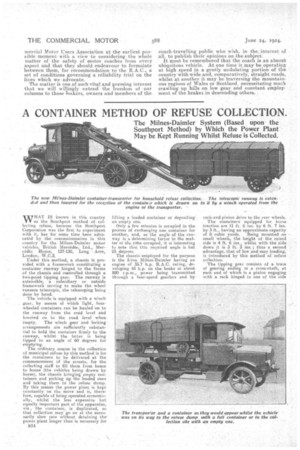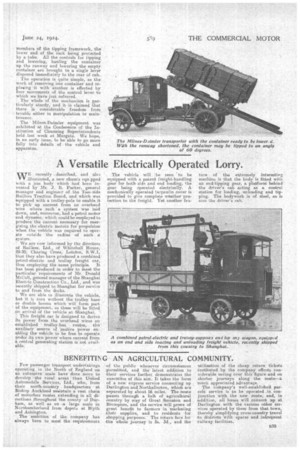A CONTAINER METHOD OF REFUSE COLLECTION.
Page 20

Page 21

If you've noticed an error in this article please click here to report it so we can fix it.
The Milnes-Daimler System (Based upon the Southport Method) by Which the Power Plant May be Kept Running Whilst Refuse is Collected.
THAT IS known in this country V V as the Southport method of collecting refuse, because the Southport Cmporation was the first to experiment with it, has for some time been advocated by the concessionnaires in this country. for the Milnes-Ttaimler motor vehicles, British Mercedes, Ltd., Mercedes House, 1277130, Long Acre, London,W.C.2.
Under this method, a chassis is provided With a framework constituting a container runway hinged to the frame of the chassis and controlled through a two-point tipping gear. The runway is extensible, a subsidiary or outside framework serving to make the wheel runners telescopic, the telescoping being done by hand.
The vehicle is equipped with a winch gear, by means of which light, fourwheeled containers can be hauled on to the runway from the road level aid lowe'red on to the road level when empty. The winch gear and locking arrangements are sufficiently substantial to hold the container firmly to the runway, whilst the latter is being tipped to an angle of 60 degrees for emptying.
The ordinary course in the collection of municipal refuse by this method is for the containers to be delivered at the commencement of the streets, for the collecting staff to fill them from house to house (the vehicles being drawn by horse), the chassis bringing empty containers and picking up the loaded ones and taking them to the refuse dump. By this means the power plant is kept constantly on the move and is, therefore, capable of being operated economically, whilst the less expensive but equally important part of the apparatus, viz , the container, is duplicated, so that collection may go on at the necessarily slow rate without detaining the' power plant longer than is necessary for lifting a loaded container or depositing; an empty one. Only a few minutes is occupied in the process of exchanging one -container for another, and, as the angle of the runway is a determining factor in the matter of the tithe occupied, it is interesting to note that this required angle is but 25 degrees.
The -chassis employed for the purpose is the 5-ton Milnes-Daimler having an engine of 35.7 h.p. 11.4.C. rating, developing 45 h.p. on the brake at about 880 r.p.m., power being% transmitted through a four-speed gearbox and by rack-and-pinion drive to the rear wheels.
The containers' equipped for horse traction are 11 ft. 6 ins. by 6 ft. 7 ins. by 3 ft., having an approximate capacity of 8 cubic yards, Being mounted on small wheels, the height of the raised side is 4 ft. 6 ins., whilst with the side down it is 3 ft. 3 ins. ; thus a second advantage, that of. low and easy loading, is introdnced by this method of refuse collection.
The tipping gear consists of a train of gearing ending in a cross-shaft, at each end of which is a pinion engaging with a rack hinged to one of the side members of the tipping framework, the lower end of the rack being protected by a tube. All the controls for tipping and lowering, hauling the container -up the runway and lowering the empty container are brought to a single lever disposed immediately to the rear of cab.
The operation is quite simple, as the work of removing one container and replaaing it with another is effected by four movements of the control lever to which we have just referred.
The whole of the mechanism is particularly sturdy, and it is claimed that there is considerable freedom from trouble either in manipulation or maintenance.
The Milnes-Daimler equipment was exhibited at the Conference of the Institution of Cleansing Superintendents held last week at Margate. We hope, in an early issue, to be able to go more fully into details of the vehicle and apparatus.






























